#Shadowrun Second Edition
Explore tagged Tumblr posts
Text
actually now I'm curious.
EDIT: Right, my personal experience is D&D 3.5, years of PF1e, a quick bout of Call of Cthulu, a year long campaign of Changeling the dreaming, Some d100 fallout thing, big campaign of Shadowrun 5e, D&D 5e, and PF2e. Haven't gotten to play PF2e in an actual campaign though, just watching and studying and running through mini adventures solo to balance test. Which is sad, but the only group I'm part of that plays it currently includes someone I'm not inclined to play with again. Also, have sat in on plenty of VtM and a bit of the Witcher RPG (and heard the tale of the campaigns like 10 times to the point I know it well.)
Most of it was PF1e. While I did enjoy my 3 year 5e campaign once I got dragged over, I'm glad to be slinking back home to Paizo. Changeling the Dreaming is my second favorite system. D&D 5e behind it. I feel like PF2e will knock PF1e down to 3rd of 4th once I can actually play the damn thing, but for now my mastery and nostalgia keep it at 1st.
128 notes
·
View notes
Text

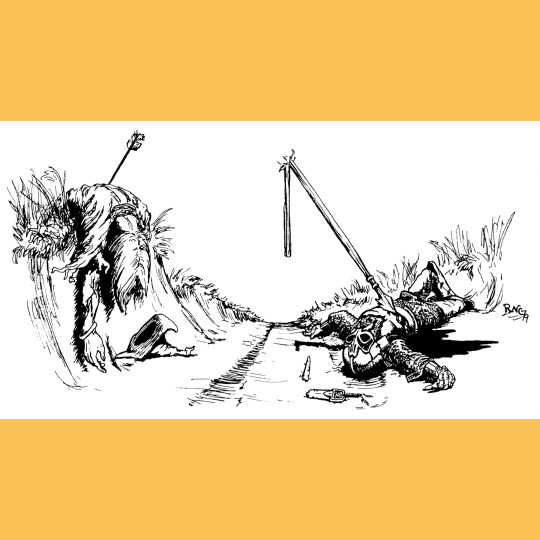
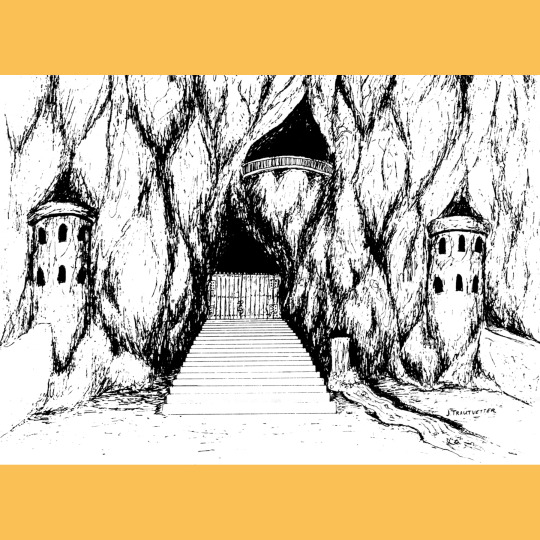
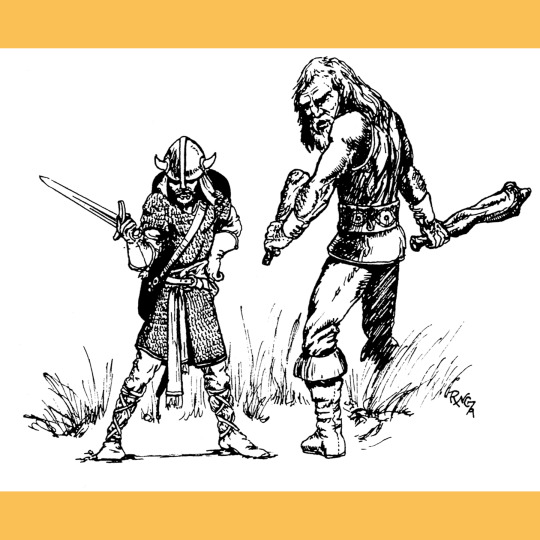
This is the second edition of The Mines of Keridav (1983) from Gamelords, a reissue of the 1979 Phoenix Games edition. It is statted for Thieves Guild but it is essentially generic, suitable for any D&D-derived system with a minimum of conversion. The basic plot is a cliché — rescue the princess from the evil wizard — but there aren’t actually a ton of scenarios where damsels are in distress, so it feels sort of novel in a weird way. The mines themselves are logically arranged and therefore extremely deadly for a frontal assault — players who want to succeed are going to need to be clever. The mage, Keridav is tough (though one with an interesting weakness — in close quarters, he is liable to get flustered and stutter, disrupting his spellcasting) and supported by a band of orcs and a menagerie of critters. Of potential help for the players, Keridav has imprisoned a population of dwarves and forced them to work the mines. His hope that the princess will naturally fall in love with him also presents unusual opportunities a smarter villain might otherwise account for.
The great thing is that the mines is only a small part of the module (just five of the 28 pages). The rest is dedicated to describing the Tiraval Valley, a number of overland hexes that include a well-realized village, a ruined castle (which would be expanded on in the companion module) and a number of encounter areas. This sort of material was more common by 1983, but when the first edition came out in ‘79, there wasn’t a ton of wilderness stuff out there and honestly, of the stuff I’ve read, this is some of the most polished and cohesive. I’d have no problem lifting this for one of my games.
Like most Gamelords books, the art is pretty solid. VM Wyman is on the cover — I like their cartoony fantasy and that lettering is great (they did a lot of work for the Thieves Guild line and it is definitely part of the charm). Bob Charrette (Bushido, Shadowrun) also has some art inside, an artifact of the book originally being published by Phoenix Games, where he started out.
90 notes
·
View notes
Note
Heya! TTRPG trick or treat, please! 🎃👻
This one's got a backstory, so stick with me.
When I first got into TTRPGs, I learned about the big 6: D&D, Pathfinder, CoC, Cyberpunk, WoD, and Shadowrun. Of those, I've still, to this day, only played 5, and Shadowrun has remained the odd man out, despite having probably my favorite setting of all of them after Pathfinder. Part of this is its reputation for being a really crunchy game, keeping me from getting players, and part of it was that it's a very crunchy game that explains its rules SO POORLY (in recent editions at least, I'm told 3rd is the best in this department) that I couldn't even really convince my friends to get over the hump because it's hard for ME to grok the rules.
For well over a decade, Shadowrun has been my white whale, always on my shelf, never my table. So I did what any other well meaning TTRPG player does when they have a setting they like but a system for that setting they hate: I looked at every hack on the planet for every other system.
So here's your treat: every Shadowrun hack I've found!
Up first, Runners in the Shadows by Mark Cleveland:
This is a Forged in the Dark hack for the Shadowrun setting that is probably one of the better ones for emulating the "crew going on heists and doing cool shit" vibes that Shadowrun tries really hard to say is its core. I'm a sucker for FitD games in general, I think the system is *so* elegant, and I struggle to find a system more suited for the setting (SR's own rules included) than Blades, so this one has to go at the top.
With that said, there are still plenty more!
I'm going to give 2 PbtA games a shout out here, the first I've played, the second I haven't, but have heard plenty about.
Up first: City of Mist!
"But that's not a shadowrun hack!" I hear you saying behind your screen, and you're almost right, it technically isn't, BUT it's asymptote certainly approaches shadowrun, for my math nerds out there. This is a game about the (literal) power of stories, about struggles against an unseen and unknowable force trying desperately to remove every semblance of magic from your life, and about the yearning to keep your mundane life despite, or maybe in spite of, your magical adventures. City of Mist proper is a fantastic gritty noir urban fantasy game that works wonderfully as the framework for an early 6th world setting with minor tweaks, but it's sequel: Metro Otherscape, leans into the Shadowrun of it all, adding a 3rd axis along which your character can struggle, being "noise". In Otherscape, you're balancing a mundane, magical, technological life, and trying not to let any of those three overwhelm your being. A lot of cyberpunk games try to say that cybernetics reduce your humanity in one way or another, but I think Otherscape does the best job at embodying that balance in a way that isn't deeply ableist in its messaging. It's ALSO the only PbtA game I actually LIKE.
Hot take: I can't stand Moves, they annoy me to no end, and needlessly complicate an otherwise brilliant system. I might make a follow up post if anyone wants to hear my deeply bad take, but for now, just know that I'm a ttrpg heretic, and we can move on.
Otherscape completely does away with moves, and instead just lets the MC and the players decide whatever is most relevant to the action being attempted! It solves almost every problem I've ever had with PbtA games, AND kicks ass as a shadowrun stand-in, so this also deserves a place at or near the top.
Second PbtA game: Shadowrun in The Sprawl. This one is a hack of The Sprawl, a PbtA cyberpunk game in its own right, SRiTS adds the setting and magic of SR to its formula, and that's all I know about either system, due to my aforementioned PbtA-phobia. I've included this one for thoroughness, not because I have any stake in it.
Most of the other hacks I've seen use generic systems like Fate, Savage World, Cypher system, Genesys, and a hero system hack I've heard a bit about but can't find anywhere. All of this is to say that there is a wealth of options for generic systems that try to emulate SR, and most of them are fine. The last game I'm going to talk about though uses its own system, its own setting, and manages to be completely, utterly unique while capturing the vibes of SR so well that I'm still a little in awe at how well it does all of the above. I'm also not 100% certain it's a particularly good game, but the fact that I'm unsure about it should tell you that it's definitely still better than SR proper, because I KNOW that system is bad.
Without further ado: NewEdo
NewEdo is fascinating to me in that it feels like the same jump from Shadowrun that 3rd edition D&D made from 2e, or even the same kind of jump from 3rd to 4th, where you can clearly see the spine of the game it's evolving, but almost every other part of the system has been changed and improved in new, interesting ways that can still be used to tell VERY similar stories, but has its own identity at the same time. I mentioned that City of Mist is Asymptotic to SR earlier, and I stand by that assessment, but I'd say that NewEdo is closer to a parallel line, or a tangent from SR's line, if we're using the same terminology. To get into the nitty gritty, NE uses a system the author describes as "Crunchy lite easily managed", which amounts to a priority system during character creation very similar to the one SR uses, but with each tier you can select having pretty impactful ramifications for your character going forward. The easiest example is the modifications priority, at its top tier, you basically make a mythical creature into robo cop for your character's ancestry, but at its absolute lowest tier, your body actively rejects any and all implants, such that your character will NEVER have implants. On the same note, cyberware is handled REALLY well, with your body only being able to handle so much at a time, but otherwise the only ramification is a "biofeedback" line on your fate card, which I'll get to right now!
Almost every option your character picks gets added to a little personalized random d100 table on your character sheet called the fate card. This includes your character's crit rate, the possibility of a deity intervening on your behalf, or the aforementioned biofeedback line, which briefly fucks you up as you cyberware malfunctions. You get new lines on your fate card through picking certain character options, making impactful decisions during the story, and otherwise fulfilling the express goals of your character. The entire system kind of hinges on the fate card as a mechanic, which is weird, because I don't think I super love it, as it adds additional rolling to an already pretty dice heavy system.
Which brings me to the dice! New edo uses a d10 as its primary die for dice pools when rolling your characteristics like strength, speed, etc, but the rest of the polyhedral family for your skills. (D20 excluded) The skill system is a little funky, but I like it. Basically, each skill has a rank, which indicates how many dice it has, but each rank is assigned a die, each having a different cost associated with it. So my swordsmanship could be rank 4, but what that really means is that I've got 1d6, 2d4, and a d8 that I get to add to my strength rolls every time I attack with a sword. As far as resolution, you total all of your dice together to try and hit a target number. I don't have the table handy, but it's something like 15 for a moderately challenging task, and up to 40 for a nearly impossible task. I dislike addition in this context because math at the table usually slows things down, but it looks like you're probably only rolling 2-5 dice at a time at the beginning, which isn't *that* bad.
You'll notice that the two major mechanics I've mentioned so far have received pretty luke-warm responses from me, and that sounds like I hate the system, but those aren't that makes me like (\love?) this system is the back end, the choices that happen during character creation, and the things that those choices let you do. Every skill is attached to feats that unlock at different skills, magic is a skill, and its feats unlock better relationships with the Kami in your repertoire (magic is up next, I promise) and your class (path, they call it) doubles as a way to tie your character to the world, with each being associated with an in world faction which gives your character an immediate stake in the world and their community. It's a lot, but it all comes together to make something greater than the sum of its parts.
The last thing I want to talk about is the magic system, because I found it deeply interesting, as it's one of the very few skill based magic systems I've interacted with, and one of my favorites on a narrative level. Instead of spells or spell schools, your character instead develops relationships with Kami, and each new "order" or "type" of Kami your character gets access to represents them finding out how to supplicate, make an offering, or otherwise convince a given Kami to do a certain effect. If you have a relationship with the fire Kami (that's plural, not singular), then your character has learned that their local fire Kami really like a certain type of hot bun, so they offer them that hot bun after a scene where they invoked those kami, to maintain their relationship. Mechanically, this works instantaneously, you simply make a roll on your "Shinpi" skill, invoke whatever "rote" you want to use, and the relationship building is left for the GM and player to work out at the table.
(That's the last I have to say on the game itself, but I would ask anyone who has read the game and is more intimately familiar with Japanese culture to tell me if the game feels respectful to that culture, because I truly don't know, and the book doesn't list any sensitivity consultants. The author is Canadian, but spent many years sailing to and from Japan as a professional sailor, so idk. )
I guess the moral to this post, if there is one, is to acknowledge when a system or setting has faults, but learn from them, and don't ignore the good or cool stuff that's there! It might inspire you to make some amazing shit like City of Mist, Metro Otherscape, or New Edo, all of which, their relationship to Shadowrun aside, are fantastic games in their own right! (NewEdo is still up in the air, but it has its teeth in me, and that has to count for something)
That ends my trick or treat, thanks for asking!
#shadowrun#ttrpg trick or treat#city of mist#cyberpunk#indie ttrpgs#ttrpg#indie ttrpg#ttrpgs#forged in the dark#powered by the apocalypse#newedo#cypher system#fate core#genesys
29 notes
·
View notes
Text
My current list of Tabletop Roleplaying Games.
13th Age
1879
A Grim Hack
Aberrant
Absolute Power
Abyss
Accursed
After The War
Anima Beyond Fantasy
Animal Adventures: The Faraway Sea
Apocalypse World
Arkham Horror The Roleplaying Game Starter Set
Ars Magica 4th Edition
Arzium
Avatar Legends Starter Set
Babes in the Wood
Badger + Coyote and their Daring Adventures 2E
BattleTech: A Time of War
Beacon Tabletop RPG
Beam Saber
Blades in the Dark
Bulldogs
Bunkers & Badasses
Cairn
Call of Cthulhu
Candela Obscura
Cantrip
Cats of Cathulhu
Chaos 6010
Champions Now
Collateral Damage
Contagion 2e
Cortex Prime Game Handbook
Cosmic Patrol
Cowboy Bebop Roleplaying Game
Coyote and Crow
Cthulhu Awakens
Cthulhutech
Cypher System
Daisy Chainsaw
Deathmatch Island
Defiant Role Playing Game
Denial & Yearning
Dialect
Dinocar
Dinosaur Princesses
Discworld RPG
Dragon Age Roleplaying Game
Dragonbane
Dread
Dream Machines
Dresden Files Accelerated RPG
Dungeon Crawl Classics
Dungeons and Dragons 3.5
Dungeons and Dragons 5e
Durance
Dwelling
Epitaph
Epoch
Essence 20
Fabula Ultima
Fantasy Age
Fate Core System
Fever Nights Role-Playing Game
Flabbergasted
Fragged Empire
Fratboys Vs
Girl By Moonlight
Glitter Hearts
Goblin Quest
Goblin Slayer TRPG
Gods of Metal: Ragnarock
Hannukkah Goblins
Have Axe, Will Travel
Hellfrost
Here, There, Be Monsters!
Hero Kids Fantasy RPG
Heroes Against the Darkness
Hopes and Dreams
Hounds
I’m the Badguy?!?
In Nomine
In the Ashes
Inevitable A Doomed Arthurian Western
Ink
Interns In The Dark
Into the Dungeon
Jiangshi: Blood in the Banquet Hall
Jordenheim
Katana-Ra
Kids on Bikes 2nd Edition
Killshot an Assassin’s Journal
Konosuba TRPG
Leverage The Quickstart Job
Lilliputian Adventure on the Open Seas
Little Fears Nightmare Edition
Lost Roads
Marvel Multiverse RPG
Mermaid Adventures
Micro rpg book
Modern Age
Monster of the Week
Moonlight On Roseville Beach
Mork Borg
Motel Spooky Nine
Musketeers vs. Cthulhu
Mutant Year Zero
My Mother’s Kitchen
Necrobiotic
Never Going Home
Night Shift: Veterans of the Supernatural Wars
Night Wolves
Numenera
Odyssey Black Tales
OneDice Pirates & Dragons
One More Quest
Ork! The RPG
Our Woodland Gods
Outcast Silver Raiders
Outgunned
Over the Edge
Overlight
Pasion De Las Pasiones
Pathfinder 1st Edition
Pathfinder 2nd Edition
Pathfinder Savage Worlds
Perils & Princesses
Pirate Borg
Power Rangers RPG
Prism
Psychic Trash Detectives
Punk’s Been Dead Since ‘79
Queerz!
Raccoon Sky Pirates
Raven
Rebels of the Outlaw Wastes
Reign
Rhapsody of Blood
Rivers of London
Ryuu Tama natural fantasy role play
Samurai Goths of the Apocalypse
Scum and Villainy
Shadowrun 5e
Shadows Of The Past
Shield Maidens
Shiver
Someone in this Tavern is a fucking mimic!
Spell The RPG
Squeeze
Star Trek Adventures Captain’s Log
Star Trek Adventures The Roleplaying Game
Star Trek Adventures Second Edition
Star Wars
Starfinder 1st Edition
Starfinder 2nd Edition
Stoneburner
Syma
Tangled
Temples and Tombs
The Bleackness
The Dark West
The Dread of Night
The Play’s the Thing
The Quiet Year
The Revenant Society
The Void
The Watch
Thirsty Sword Lesbians
This Discord has Ghosts in It
This house is Fucking Haunted
Thousand Year Old Vampire
Tomorrow City
Troika!
Unisystem
Urban Decay
Utopia
Vaesen
Vagabond
Valiant Universe
Variations On Your Body
Venture and Dungeon
Waffles For Esther
Wanderhome
Warcraft The Roleplaying Game
Werewolf the Apocalypse
What Lurks Above
What Lurks Beneath
What Lurks Beyond
World Ending Game
Yazeba’s Bed & Breakfast
Xianta Cyber Wuxia
Xoe Microplayer
Zweihander
I'll update this list as I get more. Feel free to send me ideas and also reblog this!
#ttrpg#tabletop#tabletop rpgs#ttrpg community#powered by the apocalypse#dming#roleplaying games#board games#game design#card games#gaming#dungeons and dragons#pathfinder#starfinder#call of cthulhu#My Games List
20 notes
·
View notes
Text















I'm getting a new job so I made a dnd one shot for newbies as a going away gift for my old co-workers (yeah, I'm the type that gives gifts when I leave).
Then one of them remembered last second that they had a wedding they had to go to.
It doesn't matter what group I try with. Someone will always last minute cancel. (as a forever DM, I get this all the time, but it still kills me)
So here's all the character/monster art I made for it. Feel free to do whatever with it. Throw it into your roll20 campaign or make an edit to make it into your own personal character, have fun.
We'll have our session sometime next week. I'll post the actual how -to - run materials depending on how it goes, but it'll probably be kinda jumbled string of thoughts writing. Probably not the best for newbies unless you have my specific kind of ADHD.
Oh, also this is mostly what I've been doing instead of posting art here. Takes a lot to draw up lil' guys, come up with session material and character to act for my players, but I like the TTRPG design space. Really quick to just try things out and gage from direct player reactions. I've been trying to move away from 5e but instead of being normal and just choosing something else, I've been cracking away at just making my own thing. I like some crunch, but I don't want Shadowrun. I don't actually like story systems. The "I've got a story to tell, I don't need help with that." logic from Brennan Lee Mulligan is how I've always felt ttrpgs should be, but also, players adding things to the scene is pretty compelling. I've been learning a lot about other ttrpgs.
Anyway, have fun. Sometimes playing pretend with weird rules is fun.
12 notes
·
View notes
Text
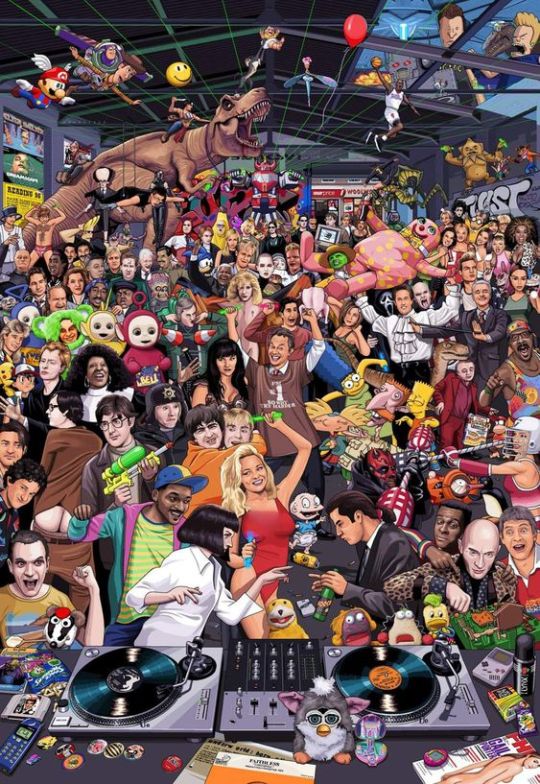
The 1990s was a pivotal decade for geek culture, solidifying many of the trends and franchises that continue to influence pop culture today. Here's an exploration of the various facets of geekdom in the 90s:
Video Games
The 1990s were a golden era for video games, seeing the rise of iconic franchises and gaming consoles.
Consoles and Games:
Super Nintendo Entertainment System (SNES) and Sega Genesis were at the forefront of the early 90s gaming scene. Classics like "The Legend of Zelda: A Link to the Past," "Super Mario World," and "Sonic the Hedgehog" became household names.
The mid-90s introduced the Sony PlayStation and the Nintendo 64. Games like "Final Fantasy VII," "Metal Gear Solid," "Super Mario 64," and "The Legend of Zelda: Ocarina of Time" revolutionized the industry with their storytelling and 3D graphics.
PC Gaming:
The rise of PC gaming brought titles like "Doom," "Quake," "Warcraft," and "Starcraft," which laid the groundwork for modern first-person shooters and real-time strategy games.
The introduction of the CD-ROM allowed for more complex and graphically intense games, expanding the possibilities of game design.
Comic Books and Graphic Novels
The 90s was a transformative period for comics, marked by a combination of innovation and market upheavals.
Marvel and DC Comics:
Marvel experienced a surge in popularity with the introduction of new characters like Deadpool and the significant events like the "X-Men's Age of Apocalypse" and "Spider-Man's Clone Saga."
DC Comics shook the world with storylines such as "The Death of Superman" and "Batman: Knightfall."
Independent Publishers:
The formation of Image Comics by former Marvel artists brought a wave of creator-owned series like "Spawn," "The Savage Dragon," and "WildC.A.T.s."
Vertigo, an imprint of DC, produced critically acclaimed titles such as "Sandman" by Neil Gaiman and "Preacher" by Garth Ennis, pushing the boundaries of mature storytelling in comics.
Science Fiction and Fantasy
The 90s were a golden age for science fiction and fantasy, both in literature and on screen.
Television:
"Star Trek" had a strong presence with "The Next Generation" continuing its success, followed by "Deep Space Nine" and "Voyager."
"The X-Files" became a cultural phenomenon, blending science fiction with horror and conspiracy theories.
"Buffy the Vampire Slayer" redefined the fantasy genre on television, combining teenage drama with supernatural elements.
Movies:
Blockbuster franchises like "Jurassic Park," "The Matrix," and "Men in Black" showcased cutting-edge special effects and imaginative storytelling.
The re-release of the original "Star Wars" trilogy in special editions prepared the groundwork for the much-anticipated prequel trilogy.
Anime and Manga
The 90s saw the global explosion of anime and manga, making Japanese pop culture a mainstream phenomenon.
Anime:
Series like "Dragon Ball Z," "Sailor Moon," and "Pokémon" became immensely popular worldwide, introducing many to the world of anime.
Films by Studio Ghibli, such as "Princess Mononoke" and "My Neighbor Totoro," received critical acclaim and international recognition.
Manga:
Manga series like "Naruto," "One Piece," and "Berserk" began their runs, setting the stage for long-lasting popularity.
The publication of "Shonen Jump" in English brought many of these series to Western audiences.
Role-Playing Games (RPGs)
The 90s were a significant decade for tabletop RPGs, with many classic games being developed and popularized.
Dungeons & Dragons:
The release of the second edition of Advanced Dungeons & Dragons (AD&D) in 1989 carried through the 90s, with campaigns like "Planescape" and "Dark Sun" becoming fan favorites.
Other RPGs:
"Vampire: The Masquerade" by White Wolf Publishing introduced the World of Darkness, a setting that offered a dark, gothic-punk alternative to traditional fantasy RPGs.
The cyberpunk genre was well represented by games like "Shadowrun" and "Cyberpunk 2020," capturing the gritty, high-tech, low-life aesthetic.
Collectibles and Trading Card Games
The 90s witnessed the birth and explosion of collectible card games (CCGs), with "Magic: The Gathering" leading the charge.
Magic: The Gathering:
Created by Richard Garfield and released by Wizards of the Coast in 1993, "Magic: The Gathering" became a groundbreaking and immensely popular game, sparking a new industry of collectible card games.
Pokémon:
The Pokémon Trading Card Game, released in 1996, quickly became a massive hit alongside the video games and TV series, contributing to the global Pokémon craze.
Internet and Technology
The rise of the internet in the 90s played a crucial role in shaping geek culture.
Early Internet Communities:
Bulletin board systems (BBS), forums, and newsgroups like Usenet allowed geeks to connect and share their interests in ways that were never before possible.
The creation of fan sites and the use of IRC (Internet Relay Chat) facilitated the growth of online communities dedicated to various fandoms.
Technology:
The proliferation of personal computers and the advent of the World Wide Web democratized access to information and entertainment, allowing geek culture to flourish and expand globally.
In conclusion, the 1990s were a transformative decade for geek culture, characterized by the rise of influential media, the advent of groundbreaking technology, and the growth of vibrant communities. The era laid the foundation for many of the trends and franchises that continue to shape geekdom today.
#90s tv shows#90s aesthetic#90s fashion#90s anime#90s music#90s nostalgia#1990s#vhs#nineties#90s movies
13 notes
·
View notes
Text
Interesting Game Mechanics ep1: Shadowrun Damage Codes
For my first of these I want to look at the damage system that Shadowrun used to have back in first, second, and third edition. It's a fun system and I'm sad that it was abandoned for later editions.
How it works:
All damage comes as a number and a letter, for instance 9M for a heavy pistol.
The letter is the level of damage: L(light), M(moderate), S(serious), and D(deadly)
The number is the difficulty for the victim to resist the damage.
A light wound inflicts 1 box of damage, a moderate wound 3, a serious wound 6, and a deadly wound is 10 (or dead). A character has 10 boxes of damage they can take.
So far so simple, but the interesting part comes from staging. Every two successes you achieve on an attack stages the damage up a level. Light becomes Moderate, Moderate becomes Serious, and Serious becomes Deadly. Likewise the victim stages the damage down during their resistance test per two successes.
So if someone gets 4 successes to hit with that pistol from earlier, it will become 9D for the victim to resist. If the victim gets 6 successes on a resistance test they would stage that 9D down to 9L and take a light wound!
Thoughts:
This system had an interesting effect of really highlighting character skill. the more dice you had the higher you could stage a damage code. someone with really high skill was able to take down strong enemies with even the weakest weapons.
There were downsides though:
First, while the system has lots of possibilities, they weren't really fully explored. In general damages were just higher number and higher level. There were never any interesting combinations like a weapon with 2D (very deadly, but easy to resist) or something with 13L (hard to resist, but needing alot of skill to make it hurt).
Second, Shadowruns basic die mechanic where you would regularly have to roll higher than 6 on six sided dice to succeed on something (a roll of 6 was rolled again and added) meant damage codes could go super high and be very hard to resist.
And Third, Damage was resisted with your body attribute. This means that if your att was too low there was no possibility to resist no matter how good your armor. Having body 1 was just a death sentence.
Summary:
All in all i'd really like to see the system come back in some other game refined and really explored. it was a great system.
7 notes
·
View notes
Text
Original Characters
Dungeons & Dragons
Veradriel Evangelou
Final Fantasy XIV
Does this count as "original"?
F'ara Mir
Pathfinder First Edition
Glabella Scipio
Pathfinder Second Edition
Niji-iro Midori
The Niji-iro Siblings
Zephyr
Mistral
Squall
Shadowrun
Erika Blume
Star Wars
Kameron Dax
Starfinder
Shimaash Llaris
Teenage Mutant Ninja Turtles and Other Strangeness
Bat-Bat
Stan
The All-American Huskies
Teenagers From Outer Space
Eric
3 notes
·
View notes
Text
Filling in a gap in the above timeline, in 1989, Tabletop Gaming Publisher FASA Corporation published a new Tabletop Roleplaying Game called Shadowrun, which was a blending of Tolkien-esque fantasy tropes that had been popularized by other RPGs before it, and the cyberpunk genre, set on an Earth roughly 60 years in the future. (This was years before "Urban Fantasy" would become a common shelf category in bookstores.)
In the 80s tabletop RPG publishers were very conscious of the PR surrounding the hobby, and the potential public perception of RPGs being a corrupting influence on children and teens. Because of this, even though Shadowrun is about independent mercenary and criminal types that corporations contract out when they need "deniable assets", they didn't feel like they could get away with putting actual common vernacular profanity into Shadowrun rulebooks and fiction.
Instead they employed the time honored Science Fiction tradition of inventing new swear words. Their "shit" substitute, "drek" comes from Yiddish, "ass(hole)" got replaced with "hoop", but for the elder statesman of cusswords, "fuck"? That became "frag". At least for the aggressive, negative connotations of the word. The sex act meaning got assigned to "slot" which could also mean "cunt".
From the context in which frag was used by Shadowrun, the Vietnam origin of the term was acknowledged. However it was not generalized to mean killing as it would later become in video games, as Shadowrun had a different slang term for that, "Geeking".
Despite the bowdlerized profanity, the early Shadowrun releases received much acclaim. By 1993, there had already been 8 tie-in novels for the setting, and in 93-96 it saw adaptations for the SNES, the Sega Genesis, and in a Japan exclusive title, the Sega CD.
So during ID Software's development of DOOM, the Shadowrun franchise was doing at least a small part to keep the word in the pop culture consciousness of the especially nerdy segment of the populace. And if they were keeping tabs on the VG industry, they would have been aware of Shadowrun even if they never even looked at tabletop gaming.
Do I have any kind of smoking gun to trace frag from SR to DOOM? No. But having lived through those years, and knowing the geek community, I do find it interesting that the timelines are so close. Just like the fact that teens who played Shadowrun in the early 90s, would have been graduating college in the late 90s right at the dawn of the dot com era, and what do you know, pretty much every first generation e-commerce website store looks like it's following the layout template of Shadowrun's first and second edition equipment sourcebooks.

39K notes
·
View notes
Text
open question to the void --
i-swear-i-have-a-point-to-get-to but Starfinder gets a second edition playtest/softcover this month and they're using the spell tradition lists for arcane, primal, occult, and divine to retain compatibility with PF2e; but it's also not really fitting with the system's overall setting or meta experience (in regards to the same sources of magic existing) besides "oh we want this content to be accessible for Pathfinder games". ok PREAMBLE DONE and the actual question is more so a setting opinion of "What's some of your favorite representations of magic in modern or sci-fi settings"? Maybe a stretched question of Psionics v Magic depending on the system. e.g., I've got honorable mentions for Shadowrun and Stars Without Number but I'd love to hear some more from people who stumble on this post
0 notes
Text
I never really appreciated just how much weird old anime my local used bookstore in my shitty little town has. Like, right now they've got Japanese import love live cds, Armored Trooper Votoms on VHS, All Purpose Cultural Catgirl Nuku Nuku, Crest of the Stars, Licensed by Royalty, Scrapped Princess, Those Who Hunt Elves, Yugo the Negotiator, the Kashimashi Karaoke disc, Melty Lancer, the Shin Megami Tensei Devil Survivor 2 anime tie in, Aura Battler Dunbine The Beautiful Warrior Grenadier...
#they had a ton of 1st and second edition Shadowrun books but they just got rid of most of them -_-#all of these dvds are like random episodes from the middle of different seasons otherwise I'd totally check them out
25 notes
·
View notes
Text
MORE COMPLAINTS
KULT: Can I make a character for your premade adventures? No? You want me to play a premade character who is so tightly woven into the adventure that it would be near impossible to change it? ...Do you want to play this adventure, KULT? Do you want me to leave so you can sit there playing with your edgy OCs? Yeah, thought so. Bye, have fun!
Shadowrun: RPGing for nearly a decade and I have literally never opened a single Shadowrun book. I know nothing about it. It is entirely possible Shadowrun is actually a Goncharov situation and everyone's fucking with me. I would have no way of knowing.
Delta Green: Hmm, burning down your entire setting and destroying everything in it is certainly a bold move for a second edition. Gotta give them that one.
Gumshoe: Ok so cards on the table- my opinions on Gumshoe are fundamentally tainted by Mutant City Blues. It's a gumshoe game where you play a super-powered cop but the rules expressly forbid you doing anything cool with your powers and focus mostly on the paperwork of police work. Now I can only associate it with that cartoonishly boring character from a sitcom whose hobbies are watching paint dry. Sorry gumshoe, I'm sure you're fun but ACAB.
Paranoia: Easily the most efficient friend removal system since the Illuminati card game went out of print.
Nobilis: It is a cliche to point out the rules for Nobilis are designed for moon goblins from the mirror dimension, so I will instead be focusing on the fact the game fluff repeatedly and specifically threatens my life. I am like 90% sure trying to play Nobilis has cursed my entire bloodline and this is only 50% a bit.
Monsterheart: I appreciate the mechanical and narrative purpose of the rule where you might be overcome with uncontrollable lust towards anyone at any time for no reason whatsoever, but its still a little unnerving.
PBTA: Ok fine. I admit that the rule where if you fail, the GM gets to punch you right in the face there and then could go down poorly in some groups.
THINGS I AM UNREASONABLY ANNOYED ABOUT BY GAME SYSTEM
D&D: Please put a disclaimer that you are not a universal system. Every time I see someone try to do a political mystery game in D&D, I take 3d10 psychic damage and have to make a death saving throw.
Pathfinder: Look. If i wanted to play a game about fighting Cthulhu there is an extremely famous game specifically designed around doing that. Literally no-one is ever going to say "Wow, I want to play a Cthulhu themed game! Time to stat up a musical halfling from a magical fantasy land!".
Chronicles Of Darkness: Just admit no-one uses any of your rules. You have Social Door Rules and Integrity Conditions and Corruption Levels and I bet at most 50% of COD players could tell me which of those I made up. Just admit people aren't dressing up as Alucard The Bringer Of Shadows because they want to sit down and do calculus.
World Of Darkness: You know that old guy who's still doing his job even though he is way too old to do it any more, but he's now an institution so you can't get rid of him? Like that. The 90s called and they want literally everything about this back.
Call Of Cthulhu: I appreciate the commitment to authenticity, but maybe stop hiring actual disgraced mental asylum directors from the 1920s to design your sanity system?
GURPS: Look. Look. Listen. We both know that you just want to write history textbooks. These are history textbooks with a few stat blocks begrudgingly put in. If you just give me a book on early Chinese history I will read it and go "ah, very interesting!". You don't need to put in a list of character choices. We're all nerds. We'll read them. Live your best life.
Powered By The Apocalypse: I actually can't think of anything wrong with PBTA. That's not a bit, this is literally the perfect system. Take notes everyone else.
Mutants and Masterminds/Heroes System: Your systems have probably the most customizable character creation in the world and you both just make reskins of the Justice League over and over again. Maybe we only need one "thinly veiled copyrighted characters" setting? You can fight over it once you decipher your combat mechanics.
FATE: Ok I won't lie, I have no idea how the fuck FATE works. I have read the rules repeatedly and played three games and I still have no idea what invoking an aspect means. I don't know why. I grasped the rules of fucking Nobilis but this one just psychologically eludes me. This is more a problem with me I guess, but I'm still annoyed.
Warhammer 40k: Have you considered spending less on avocado toast? Then you might be able to afford to charge less for things?
Exalted: Apart from the lore, the setting, the mechanics, the metaplot, the character creation and the dodgy narrative implications, I can't think of anything to improve here.
3K notes
·
View notes
Text
Useless Equipment of Shadowrun (1st Edition). The High-Intensity Veracity Examiner
“This state-of-the-art device measures voice stress, pulse rate, and minute contractions and expansions in the subject’s corneal blood vessels while the operator leads the subject through a series of questions.”
You mean a lie-detector? Or a…
Tyrell: …Capillary dilation of the so-called blush response? Fluctuation of the pupil. Involuntary dilation of the iris...
Deckard: We call it Voight-Kampff for short.
Yup.

Good thing Shadowrun has replicants androids OH WAIT THEY DON’T.
You know what else Shadowrun doesn’t have?
Rules for using this device.
It’s a 50,000 ¥, 5-kilogram brick in “high-impact carrying case”.

“Why did you buy it, Leon?”
The equipment listing puts it at Rating 8, except it is written nowhere how that Rating is used for any test. For Surveillance Measures and Countermeasures, the Rating serves as both Skill and Target Number for opposed tests, but this is not stated for Security Devices.
Back in the skills chapter, there is the Machine-Aided concentration of Interrogation, for which there is Lie Detectors and Voice Stress Analysis listed as possible specializations, so I would assume that the Device Rating is used as the Target Number for resisting the test. Interrogation “depends upon the subject’s Willpower Attribute Rating”, so it would be:
Operator’s Interrogation skill (Target Number = subject’s Willpower) vs. Subject’s Willpower (Target Number = Device Rating)
In fact, there are no rules for any of the Security Devices: Identification Scanners (Thumbprint, Palmprint, Retinal, Maglock) and Restraints (Metal, Plastic, Squealer). Later publications address this absence; Sprawl Sites has rules for credstick interrogation by security scanners (though it uses the Negotiation skill), and 2nd Edition Shadowrun clarifies that the Restraint Rating is a Barrier Rating.
2nd Edition also ditches the H-IVE entirely.
Wait a second. HIVE? Maybe it’s not replicants they’re trying to find, maybe is…

7 notes
·
View notes
Text
STMPD Recommends Bubblegum Crisis Fanfiction - Resources: The Licensed Bubblegum Crisis RPG Books
No. Not my own RPG. That's... in a state of transition. I broke a bunch of stuff in it and will probably need to get back to it someday to fix it. Not high on my priority list.
And no, not the Shadowrun Second Edition Partial Conversion drafted up by Neo No Armor Against Fate's Shawn Hagen. Apparently Shawn maintains that his RPG conversion is better, said he was able to dissect the combat easily on Usenet back in the day. And he might very well be right in terms of mechanics, except, oh, wait, probably not, because it's Shadowrun, amirite folks?
Thank you, thank you, thank you. I'll be here all week.
No, I don't claim to make any defenses for the BGC RPG as an RPG book, and I'll explain what I mean in a bit. I will, however, argue that these sterling little books, published in the two years before R. Talsorian went dormant for nearly two decades (cyberpunk 3.0 notwithstanding), are hands-down the best 'guides' to Crisis 2032 you could ever want. If you're writing fiction in 2032, and maybe you're pressed for ideas, I say give these three books, each shorter than the last, a read...
Which you can do electronically, for free, right here.
This is going to take awhile, isn't it? Well, yeah, we're talking a few hundred pages of small-font text and some really good settei (concept art) serving as the pictures, some of which saw no reproduction outside Japan at all. So, like the multi-part epic rant I've had brewing in my drafts folder for the past half a year, let's break it down into sections. We'll start with
DON'T ACTUALLY PLAY BUBBLEGUM CRISIS: MEGATOKYO 2033 THE ROLEPLAYING GAME: ARU PEE GEE NO DENSETSU
For context, and this is kind of an interesting story: R.Talsorian Games, the primary publisher behind the OGBGCRPG (OG for short) made its fame on two big product lines.
First there was wargame / RPG hybrid Mekton, pioneered by Mike Pondsmith back in the eighties as a mecha fighting game, in the halycon days when most anime watchers got fansubbed tapes from conventions or were watching rebranded Voltronesques on Saturday mornings. Anime fandom as we know it, or even knew it in the nineties, just did not exist, and here's Pondsmith drawing up a whole fucking wargame to do it. The most recent edition circa the nineties was Mekton Zeta, which also had the mecha-building sourcebook Mekton Zeta Plus.
The other was Cyberpunk 2013, released in 1988, which was essentially a street level adaptation of Mekton's mechanics (called 'Interlock' 'cause all the systems could, e-hem, interlock), that got a cool sourcebook or two (including one inspired by cyberpunk classic Hardwired that was written by the novel's author) before getting a second edition in like '89 or '90. That's Cyberpunk 2020 - that's what put R.TAL on the map, that's what I wrote a shitty fanfic crossing with BGC about (It wasn't hard to do), that's what became Cyberpunk 2077, and that's also what became Cyberpunk RED once R.Tal got money from CDPR to make a new edition.
With me so far? I bet you're thinking, Kyle, "gosh and golly gee wilikers so they put their anime system together with their cyberpunk system, because all those parts interlocked just like you said, and they made Bubblegum Crisis!"
And oh, my sweet summer child, how your eyes are shut.
Yeah... So, the OG is actually run on a system called Fuzion, which blends R.Tal's loose network of systems with that of the HERO System, which is... one of those really complicated universal systems that they say can build anything and everything, was designed with a variety of advantages and disadvantages for characters to use to represent their character, and isn't GURPS. No, it was made more for a superhero RPG, I guess?
Anyway, somehow the two companies met, decided to make a joint universal system for all their work going forward, and called it Fuzion. Many other licensed games used it for awhile, people made universal themed supplements for it, but it's not in wide use anymore as far as I know.
Why? Let me see if I can explain by way of picture.
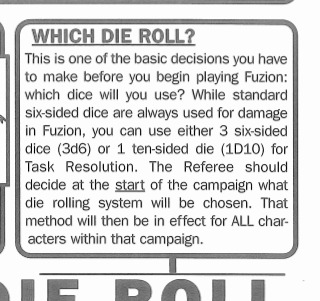
Champions used 3d6. Interlock used a d10. The devs argued and argued and argued over which type the game should be balanced around, then gave the fuck up. Does that fill you with confidence, readers?
So there's this sort of... highly elaborate mishing and mashing of various elements of two very different systems such that neither comes out the better for wear. Here's R.Talsorian's Lifepath, a character-backstory generator where you roll dice to build a character (setting-agnostic, because they were trying to sell a universal system); then here's Champions's Perks and Complications, bought using those same precious campaign points you're using to buy civilian gear (but aren't your players playing as Knight Sabers? Who needs real shit to be marked when you're building hardsuits with separate points entirely?), and complications must be activated x amount of times a session even if it diverts from the fun of playing the game. And so on and so forth. Shit, even crossing Cyberpunk with Mekton doesn't always work, since blocks of damage from Mekton (Kills) scale unsteadily with the more dice-driven combat of CP. Worse still is that the mecha system and the hacking system are off in MZ+ and CP2020 respectively, so if you want to custom-build hardsuits beyond the small pool of tools you're given on the last fucking page of the book, or you want your Nene equivalent to do something useful, nyah-nyah, go buy more books.
And then I'm sure Shawn Hagen has plenty of reasons why the combat doesn't work, but we're not paying attention to him. Whatever. Let's talk about what does work, which is a mix of worldbuilding lore, stuff the R.Tal writers seemed to just sort of come up with, and a great gallery across all three books of Fucking Cool Mecha (especially BGC EX).
LORE IS SERIOUS BUSINESS FOLKS
I mean that earnestly. It's hard to get right, especially when said lore reflects upon the tone of the actual content, the plot, the franchise, whatever. But when telling stories with a licensed game, some degree of lore is, to my mind at least, incredibly mandatory. Maybe not so much for games where the story ought to be made up as one goes along (see RPG's like The Sprawl), but in the case of BGCrisis, an anime which at the time had a pretty loyal fanbase chomping at the bit for answers for their questions about the wider universe the Sabers operated in, R.TAL had to do a mix of cribbing from untranslated material, the B-Club special and all that, and making their own shit up without looking like they'd cribbed from their own work (CP2020) overmuch. The result is very uneven, but charmingly so. I almost want to say it feels more grounded than CP2020 or Shadowrun, but is that just because it's comparatively light on the ground? Perhaps. The mandatory universe timeline is one page, and focuses more on putting years to events that were already canon instead of adding extraneous stuff in.
Likewise with what the politics look like worldwide. We get a few paragraphs about how the U.S. is recovering (not collapsed as in CP2020), Japan is doing pretty good for itself as GENOM's puppet-state, Russia successfully integrated into the EU even if Eastern Europe didn't (See? Wacky shit like that can only be called charming), and China's one big North Korea (which I think is a holdover from the CP2020 Pacific Rim Sourcebook, where Deng was assassinated by Maoist radicals.) We get another dry bit about the idea of a zaibatsu lifted straight from CP2020's Corpbook 1, where Arasaka is discussed... newspapers are now faxed (look it was in BGC OVA 1 what do you want me to tell you)... on and on it goes.
I suppose I like the lore independent of the actual characters because of a few clever predictions. One is using all the cybernetics-gone-bad in AD Police Files to explain why nobody has them in the 2032 OVA, a link I sense wasn't really made concrete until this RPG. It's one of the most interesting interpretations of the source material and of cyberpunk tropes I've seen, you know, where all the splicing and dicing of the body turns out to be a fad and a failure, leaving those who bought into the trend left with butchered and failing bodies - in light of the crypto crash that seems to be dragging the stock market down back into recession / stagflation, that seems pretty classic capitalism.
The other is tied to Before And After, covering the impact of the cheap and now even more ubiquitous Boomers of Crash:
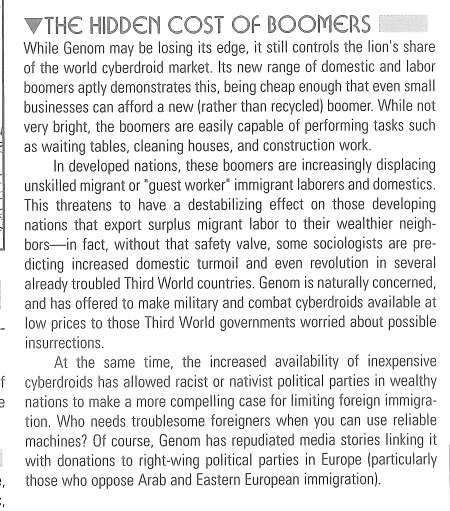
I mean, what can I say? I like predictions of the future that actually consider the effects of hyper-futuristic technology in that sort of way.
That's what a lot of the RPG's lore is at its best, basically working overtime to paper in the gaps left ignored by the series' creators. So we get a nuanced look into how ADAMA is different than similarly-sentient Boomers from the ADPF OVA; we get the Largo = Mason + Boomer Messiah explanation theory that the internet came up with just a year or two prior to the RPG's publishing; we get conspiracy theory proposals about whether or not GENOM undermined the cybernetics market to replace the enhanced with Boomers; we get to see the ADP go from hotshot riot suppression force able to slaughter undesirables en masse to actively disdained by GENOM; a weird consideration of how recognizing Boomer rights could still serve GENOM's agenda... on and on and on. It's such a mishmash of ideas, beautiful because of it.
Obviously no sane RPG player would ever give a rat's ass about any of this, but again, this was a product also marketed towards fans who just wanted a good worldbuilding book. I'm not saying you should take every part of the RPG's world into your own fanfiction, but you can take a great deal of it in and things will hold up.
POWER CREEP? YEAH, I'VE GOT THE POWER, CREEP!
The actual sourcebook sections of the sourcebooks are a) the characters, and b) the mecha. That's it, that's all. Civilian gear is almost an afterthought shoved into the front of the book like it didn't need to be there, cybernetics don't show up until Before and After. For although there is a section in the corebook proposing non-Saber campaigns players can run, they're essentially permutations of the already-existing types from CP2020: Corporates, mercenaries, medias, etc. And why, I ask you, would you run anything else but your own fanmade Saber team in your home city, overgrown and under threat? Shit, RTAL even went out of their way to put a few pages in EX, the last book in the series, highlighting player campaigns with online presences (Geocities, email addresses, etc.) and describing them in brief. Oh, to be a fly on the wall for the play sessions of the guys who did Mega-Gotham...
Anyway, back on topic. Both character pages and mecha pages get a great deal of settei transposed onto these pages, concept art ripped straight from Artmic's design docs and provided, again, more as a nerd resource than anything super useful. This especially comes into play in BGC: EX, where all the concept art and mecha are instead from everything that wasn't animated. Rejected concepts for hardsuits with wheels for feet; Boomer sketches only found in old hobby magazines; scribbles one of the Crash! mecha designers tried to get in that were apparently labeled 'problematic' (I guess he was a toy designer before all this?). I unironically love all this shit, even the beam cannons mounted on a hardsuit right where the boobplates are. Shit, my Discord profile pic is a non-Boomer mecha supposedly used by the JSDF, a 'Battlemover' whose origin I have no idea about, but which looks cool as hell. That's the kind of weirdo fan I am.
My point is that if you need to spice up your fiction, throwing 'new Boomer X' at the Sabers is one thing, giving the Sabers some power-up parts you dreamed up is another, but using the designs Artmic came up with before you did is more galaxy-brained than either. Shit, I should know, it was what Craig Reed did for the fanfics that I continued off of back in the day. And it's the same with these extraneous lore details that some rando RTAL staffer dreamed up a quarter-century ago, because they beg to have an entire fanfic made about any one of them. What happened to Jeena, folks? Inquiring minds want to know.
Anyway, that's it. That's all. Read through these and be a better fan because of it.
4 notes
·
View notes
Text
I thought initially that you were asking for TTRPGS you could use a base for your own wordbuilding, but I see from the replies that I have the wrong end of the stick, and you want to read other people's unusual RPG world building...
I therefore offer up two RPGs I have encountered, with varying flavours of "interesting":
"Worldtree" is a fantasy RPG set on a world which is, as the name suggests, one giant tree, with different civilisations living and dying on various branches, with a surprising level of modern day convenience fueled by magitech, which comes in the form of the gifts to the world of ancient gods, the power of which waxes and wanes depending on which gods are active and which gods are taking a nap...
And "HC SVNT DRACONES", which I am absolutely sure is titled that way because the writer misread the phrase "Hic Sunt Dracones", is the anti-Shadowrun of futuristic sci-fi games, in that it A) steers away from the fantasy route by going full gene-splicing, aliens and high technology instead and B) is explicitly pro-corporation. It has a thorough treatise on the history of the colonisation of the solar system, complete with psychic slenderman martian owls, but all of it is underpinned by the sincere belief on the part of the author that the concept of the Free market is a sacred philosophical concept and that corporations must genuinely have their customers beat interests at heart or else they wouldn't have customers anymore. I must note that my memory of it is based on first edition: it apparently has a recent-ish second edition, and I have no idea if the author had someone take them by the hand and teach them to stop fellating the corpos in the meantime.
Anybody got any good recommendations for ttrpgs if I'm primarily looking for extended loredumps about a setting with little to no intention of trying to run a game? I being realistic about my social prospects, and worldbuilding
108 notes
·
View notes
Photo
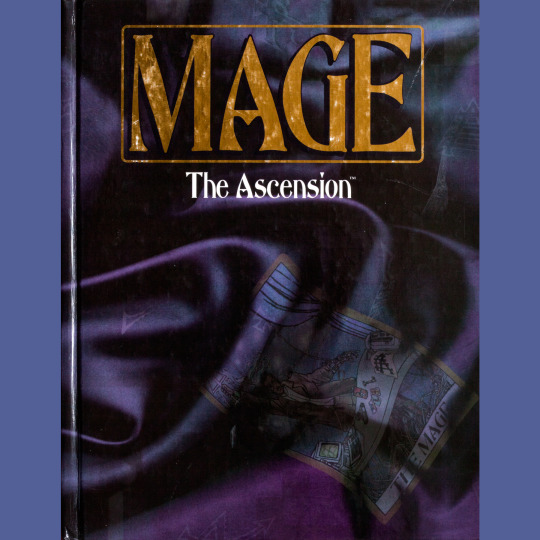
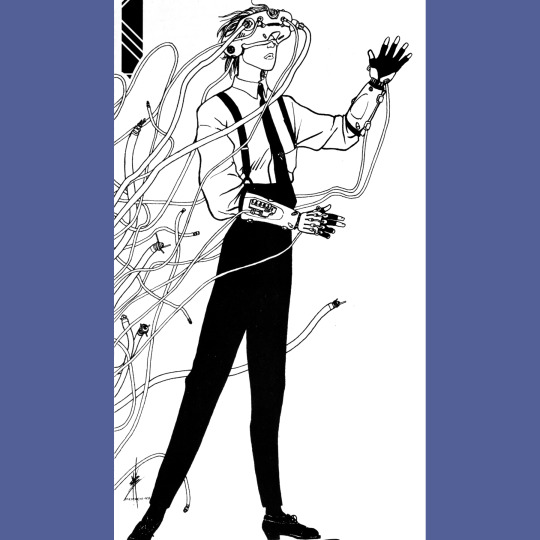


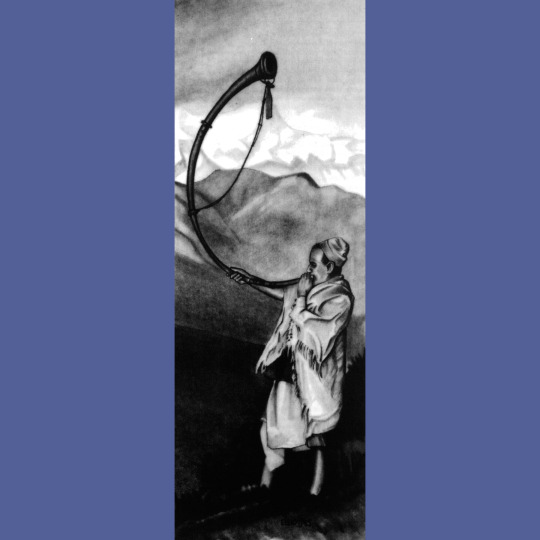
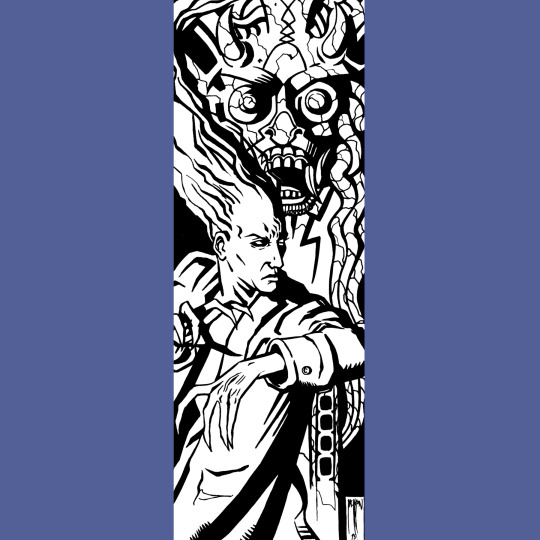
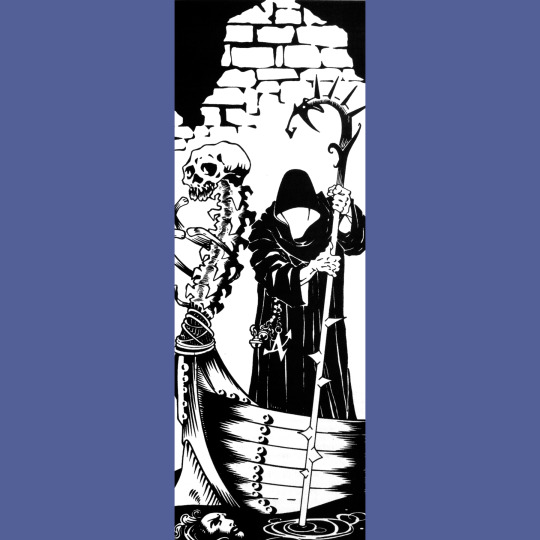
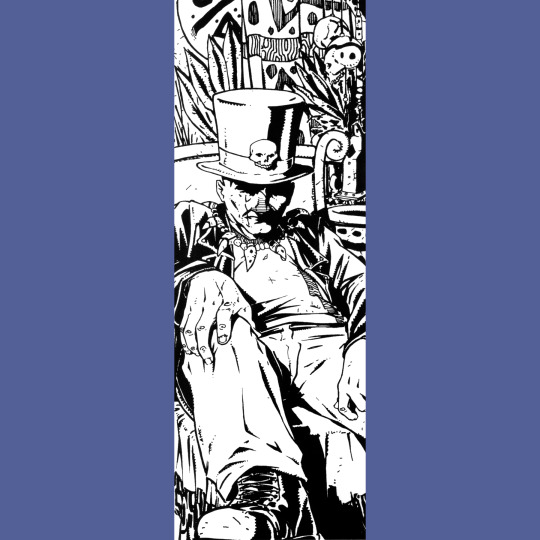

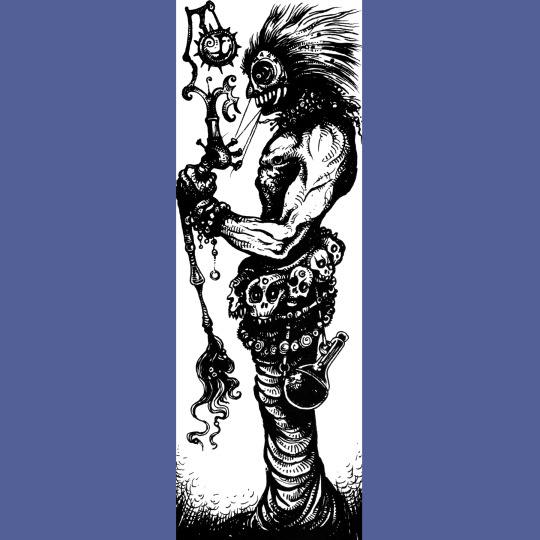
Mage: The Ascension (1995 second edition) is the third World of Darkness game, following Vampire and Werewolf. Unlike the previous games, which explore the idea of player-as-monster, Mage casts players as spiritually awakened and seeking to either wake or keep sleeping the masses of humanity. The main attraction is the open ended magic system (we’re gonna barely scratch the surface here, sorry).
In brief, the world of Mage is a reality defined by consensus. Magic is the process by which the awakened can alter or subvert that consensus through force of will. If that magical effect is too exposed to the consensus (basically, if enough normal people witness it and recognize it as breaking the laws of reality) then reality will re-assert itself and the mage will experience blowback called Paradox, which generally involves the mage getting their face blown off. So the idea is to basically…choose the effect you’re looking to achieve, pick the type of magic you’re going to use and come up with a clever way to pull the wool over reality’s eyes so you don’t melt or explode.
This is really, really cool. And made more so by the fact that the framework for the game draws on real world esoteric traditions and philosophy. So it feels…I don’t want to say real, but I guess plausible and familiar is a good way to put it. Because real world esoteric tradition is rife with complexity, the complexity of the fictional systems inherit a bit of verisimilitude.
This is either going to sell the experience for you, or drive you absolutely insane (or, in my case, both simultaneously). And that’s as a player, who only needs to be conversant in a small slice of magical mechanics. GMs need to understand all nine traditions, how the interact and the vast web of White Wolf lore that seems designed to obfuscate everything. That means a Mage GM is a very, very specific and perhaps non-existent sort of person. You could not pay me enough money to run Mage. I’d rather run Shadowrun. But I like reading Mage!
#RPG#TTRPG#Tabletop RPG#Roleplaying Game#D&D#dungeons & dragons#World of Darkness#Mage#Mage the Ascension#White Wolf
102 notes
·
View notes